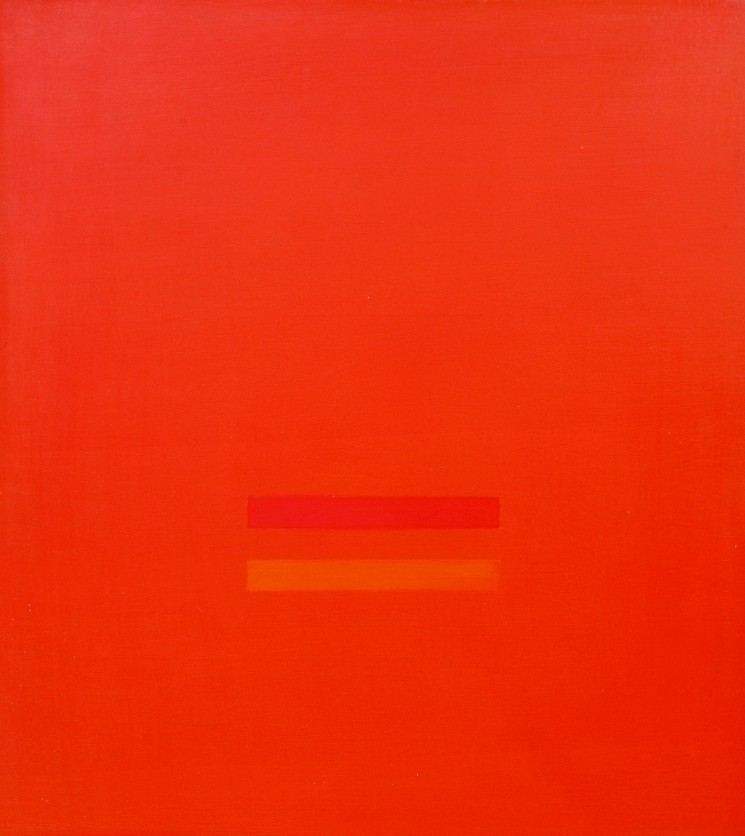Antonio Calderara
Spazio, Colore, Luce

„A show of eternity, a truth that reflects our hope, our ability, our belief, our self.“
Antonio Calderara (1903-1978) created one of the most poetic and most subtle œuvre of 20th century Italian painting. The autodidact repeatedly underwent a process of strict artistic reflection and since the 1930s passed through a quick succession of a diversity of stylistic phases. Alongside still lives reminding the viewer of Giorgio Morandi stand post impressionistic landscapes, figure paintings and portraits, which make stylistic reference to the New Objectivity. Caldera as well always pointed out his artistic proximity to Piero della Francesca.
From the 1950s on, the deeply emotional experiencing of his home country, the landscape and light at the Orta Lake in Piedmont, Italy, turned into his most favoured subjects. In the process of reaching an ever higher level of abstraction he ultimately distanced himself completely from landscape and architecture in his series of Orta Lake works. In 1954, his analysis of works by Piet Mondrian had a profound effect on his works. According to his own perception it was in 1959 that he painted his first purely abstract work. From then on Calderara developed an abstract, softly coloured style close to Josef Albers, which, according to him, meant turning proportion, colour and light into maxims of his painting.
Throughout his life Calderara maintained close relationships to artists of his time. His collection of works that he compiled by exchanges, includes works by Fontana, Manzoni, Soto, Uecker or Mack. He furthermore maintained close relationships with artists of the Munich based ‘Studio UND’ and from 1965 on had Europe-wide group exhibitions under the title ”Conceptional Art” together with Albers, Jochims, Girke, Fruhtrunk, Prantl and Gappmayr. Calderara exhibited at the ”Kestnergesellschaft” in Hanover and in 1968 at the documenta of the same year. The exhibition at the ”Kunstmuseum Luzern”, Switzerland in 1969 and the ”Galerie im Taxispalais”, Innsbruck, Austria, in 1971 deserve special mentioning. In 2003, the ”Staatliche Graphische Sammlung” in Munich dedicated a large-scale retrospect to Calderara as well as the ”Joseph Albers Museum, Quadrat Bottrop”, Germany, with its ”Hommage to his 100th birthday”. In 2011, the ”Museum Ritter” in Waldenbuch, Germany, followed their example.
In his small, almost intimate painting formats like the work „Spacio, Colore, Luce“ from 1972 (oil on wood, 27 x 24 cm) Calderara applied up to 40 glazes on top of each other, which contain all tonal values of the colours used in the painting. He nevertheless differentiated the different portions of the painting via value differences and at the same time combined them via colour relationships as well as a consistent application of colour. The result of this layer painting is a depth of light, which gives the works a uniform light. Due to this systematisation and reduction his late works are particularly influenced by a strict rectangular, differentiated structure. The golden ratio, complicated number- and proportional ratios determine the work’s composition.
Calderara always pointed out that in its essence his painting never changed. It therefore consequently was guided by the singular and dictating motive of his painting: light. Following the example of Platon and the Neoplatonism he aimed for a light that did not represent anything but itself. Based on the poetic and luminous coloration as well as the harmonic painting structure he aimed for the so-called ”space of light”. In this ”Spazio Luce“ according to the artist, the chromatic element turns into a light effect (atto di luce) and the substance turns into a newborn luminous form (forma luminosa suscitata). Finally, Calderara wanted to guide the viewer into a mental ideal space, the ”Spazio Mentale“, which takes place in the viewer’s imagination. “Not the concrete but the imagined reality, which coincides with the world of ideas, thoughts and phantasy. The hope for the possible, the certainty of existence, the invention of the truth.”
Based on his own existential personal experiences the artist viewed life and death as a unity and in his works realised ever new formulations of the thought of nothingness as a whole. His close friend and fellow painter Raimer Jochims describes his meditative, spiritual, and very poetic works as ”images of infinity in a finite form. They represent his dialogue with the everlasting dimension of the being. Eternity is immortal. His works therefore were not images of silence but a dialogue at the edge of nothingness, a dialogue that until the end kept getting more and more lonely, cheerful and intellectual.“